

The Feynman Lectures on Physics. PHYSICS MAP. Pauli exclusion principle. Wolfgang Pauli formulated the law stating that no two electrons can have the same set of quantum numbers.

Astronomers discover closest potentially habitable planet: Wolf 1061c. The closest potentially habitable planet ever found has been spotted by Australian scientists, and it's just 14 light-years away.

That’s 126 trillion kilometres from Earth, which sounds impossibly far, but when you consider that our closest planetary neighbour, Mars, is 249 million km away, that handful of light-years doesn’t seem so bad in the scheme of things. Named Wolf 1061c, the newly discovered planet is located in the constellation Ophiucus, and its star is the 35th closest star from Earth - that we know about. The team behind the discovery says it's orbiting a red dwarf 'M-type' star called Wolf 1061, alongside two other planets. All three are suspected to be rocky like Mars, rather than gaseous like Neptune. Femtotechnology. Femtotechnology is a hypothetical term used in reference to structuring of matter on the scale of a femtometer, which is 10−15 m.
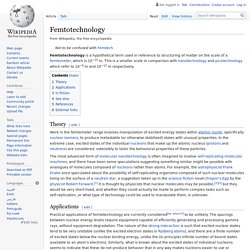
This is a smaller scale in comparison to nanotechnology and picotechnology which refer to 10−9 m and 10−12 m respectively. Overview[edit] Work in the femtometer range involves manipulation of excited energy states within atomic nuclei, specifically nuclear isomers, to produce metastable (or otherwise stabilized) states with unusual properties. Quantum entanglement. Quantum entanglement is a physical phenomenon that occurs when pairs or groups of particles are generated or interact in ways such that the quantum state of each particle cannot be described independently – instead, a quantum state may be given for the system as a whole.

Such phenomena were the subject of a 1935 paper by Albert Einstein, Boris Podolsky and Nathan Rosen,[1] describing what came to be known as the EPR paradox, and several papers by Erwin Schrödinger shortly thereafter.[2][3] Einstein and others considered such behavior to be impossible, as it violated the local realist view of causality (Einstein referred to it as "spooky action at a distance"),[4] and argued that the accepted formulation of quantum mechanics must therefore be incomplete. History[edit] However, they did not coin the word entanglement, nor did they generalize the special properties of the state they considered. Concept[edit] Satyendra Nath Bose. Satyendra Nath Bose, FRS[2] (1 January 1894 – 4 February 1974) was an Indian physicist specialising in mathematical physics.
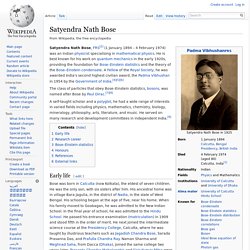
He is best known for his work on quantum mechanics in the early 1920s, providing the foundation for Bose–Einstein statistics and the theory of the Bose–Einstein condensate. A Fellow of the Royal Society, he was awarded India's second highest civilian award, the Padma Vibhushan in 1954 by the Government of India.[5][6] The class of particles that obey Bose–Einstein statistics, bosons, was named after Bose by Paul Dirac.[7][8] A self-taught scholar and a polyglot, he had a wide range of interests in varied fields including physics, mathematics, chemistry, biology, mineralogy, philosophy, arts, literature, and music. He served on many research and development committees in independent India. Gluon. Gluons /ˈɡluːɒnz/ are elementary particles that act as the exchange particles (or gauge bosons) for the strong force between quarks, analogous to the exchange of photons in the electromagnetic force between two charged particles.[6] In technical terms, gluons are vector gauge bosons that mediate strong interactions of quarks in quantum chromodynamics (QCD).
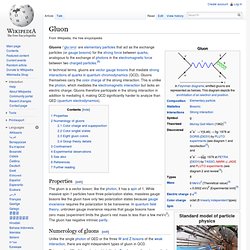
Gluons themselves carry the color charge of the strong interaction. Richard Feynman. Feynman developed a widely used pictorial representation scheme for the mathematical expressions governing the behavior of subatomic particles, which later became known as Feynman diagrams.
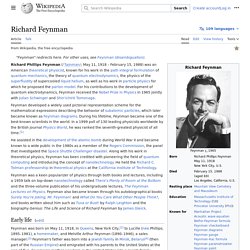
Introduction to quantum mechanics. Many aspects of quantum mechanics are counterintuitive[3] and can seem paradoxical, because they describe behavior quite different from that seen at larger length scales.
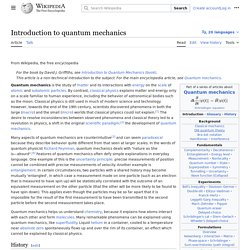
In the words of quantum physicist Richard Feynman, quantum mechanics deals with "nature as She is – absurd".[4] For example, the uncertainty principle of quantum mechanics means that the more closely one pins down one measurement (such as the position of a particle), the less accurate another measurement pertaining to the same particle (such as its momentum) must become. The first quantum theory: Max Planck and black-body radiation[edit] Hot metalwork. The yellow-orange glow is the visible part of the thermal radiation emitted due to the high temperature. Everything else in the picture is glowing with thermal radiation as well, but less brightly and at longer wavelengths than the human eye can detect. Uncertainty principle. Introduced first in 1927, by the German physicist Werner Heisenberg, it states that the more precisely the position of some particle is determined, the less precisely its momentum can be known, and vice versa.[1] The formal inequality relating the standard deviation of position σx and the standard deviation of momentum σp was derived by Earle Hesse Kennard[2] later that year and by Hermann Weyl[3] in 1928: (ħ is the reduced Planck constant, h / 2π).
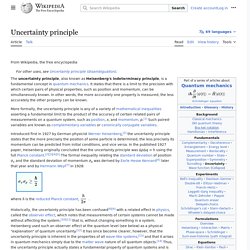
Since the uncertainty principle is such a basic result in quantum mechanics, typical experiments in quantum mechanics routinely observe aspects of it. Certain experiments, however, may deliberately test a particular form of the uncertainty principle as part of their main research program. Wave–particle duality. Origin of theory[edit] The idea of duality originated in a debate over the nature of light and matter that dates back to the 17th century, when Christiaan Huygens and Isaac Newton proposed competing theories of light: light was thought either to consist of waves (Huygens) or of particles (Newton).

Through the work of Max Planck, Albert Einstein, Louis de Broglie, Arthur Compton, Niels Bohr, and many others, current scientific theory holds that all particles also have a wave nature (and vice versa).[2] This phenomenon has been verified not only for elementary particles, but also for compound particles like atoms and even molecules. For macroscopic particles, because of their extremely short wavelengths, wave properties usually cannot be detected.[3]
Quantum tunnelling. Quantum tunnelling or tunneling (see spelling differences) is the quantum mechanical phenomenon where a subatomic particle passes through a potential barrier. Quantum tunneling is not predicted by the laws of classical mechanics where surmounting a potential barrier requires enough potential energy. Quantum tunnelling plays an essential role in several physical phenomena, such as the nuclear fusion that occurs in main sequence stars like the Sun.[1] It has important applications in the tunnel diode,[2] quantum computing, and in the scanning tunnelling microscope. The effect was predicted in the early 20th century, and its acceptance as a general physical phenomenon came mid-century.[3] Fundamental quantum mechanical concepts are central to this phenomenon, which makes quantum tunnelling one of the novel implications of quantum mechanics. Superpartner. In particle physics, a Superpartner (also sparticle) is a hypothetical elementary particle.
Supersymmetry is one of the synergistic theories in current high-energy physics that predicts the existence of these "shadow" particles.[1][2] The word sparticle features the s- prefix which is used to form names of superpartners of the individual fermions, e.g. the stop quark. Theoretical predictions[edit] According to the supersymmetry theory, each fermion should have a partner boson, the fermion's superpartner, and each boson should have a partner fermion. Exact unbroken supersymmetry would predict that a particle and its superpartners would have the same mass. Tachyon. Because a tachyon would always travel faster than light, it would not be possible to see it approaching. After a tachyon has passed nearby, an observer would be able to see two images of it, appearing and departing in opposite directions.
Black Knight satellite. Photo of a thermal blanket let go from the International Space Station during STS-88; claimed by conspiracy theorists to be the Black Knight satellite. The Black Knight satellite is claimed by some conspiracy theorists[1] to be an object approximately 13,000 years old of extraterrestrial origin orbiting Earth in near-polar orbit. Critics and mainstream academics have called it a conspiracy theory and a myth.[2][3]
Cosmic ray. Cosmic flux versus particle energy Etymology[edit] The term ray is somewhat of a misnomer due to a historical accident, as cosmic rays were at first, and wrongly, thought to be mostly electromagnetic radiation. In common scientific usage,[6] high-energy particles with intrinsic mass are known as "cosmic" rays, while photons, which are quanta of electromagnetic radiation (and so have no intrinsic mass) are known by their common names, such as gamma rays or X-rays, depending on their photon energy. Massive cosmic rays compared to photons[edit] In current usage, the term cosmic ray almost exclusively refers to massive particles - those that have rest mass - as opposed to photons which have no rest mass. The Standard Model of Particle Physics.
How Big Is Space – Interactive version. Giant Magellan Telescope. The Giant Magellan Telescope (GMT) is a ground-based extremely large telescope planned for completion in 2025.[5] It will consist of seven 8.4 m (27.6 ft) diameter primary segments,[6] with the resolving power of a 24.5 m (80.4 ft) primary mirror and collecting area equivalent to a 22.0 m (72.2 ft) one,[7] (which is about 368 square meters).[4] The telescope is expected to have over five to ten times the light-gathering ability of existing instruments. Three mirrors have been cast and the mountain top is being prepared for construction.[8][9] A total of seven primary mirrors are planned, but it can begin operation with four.[9]
Top 10 Unexplained Mysteries of the Stars. Space. Eta Carinae. Coordinates: 10h 45m 03.591s, −59° 41′ 04.26″ 67P/Churyumov–Gerasimenko. 67P/Churyumov–Gerasimenko (abbreviated as 67P or 67P/C-G, and written in Cyrillic as комета Чурюмова — Герасименко) is a comet, originally from the Kuiper belt,[6] with a current orbital period of 6.45 years,[1] a rotation period of approximately 12.4 hours[5] and a maximum velocity of 135,000 km/h (38 km/s; 84,000 mph).[7] Churyumov–Gerasimenko is approximately 4.3 by 4.1 km (2.7 by 2.5 mi) at its longest and widest dimensions.[8] It was first observed on photographic plates in 1969 by Soviet astronomers Klim Ivanovych Churyumov and Svetlana Ivanovna Gerasimenko, after whom it is named.
It came to perihelion (closest approach to the Sun) on 13 August 2015.[9][10][11][12] Discovery[edit] Eta Carinae. Carina Nebula. Coordinates: 10h 45m 08.5s, −59° 52′ 04″ "Eta Carinae Nebula" redirects here. History of string theory. The history of string theory spans several decades of intense research including two superstring revolutions. Through the combined efforts of many different researchers, string theory has developed into a broad and varied subject with connections to quantum gravity, particle and condensed matter physics, cosmology, and pure mathematics. D-brane. Fermi Gamma-ray Space Telescope. The Fermi Gamma-ray Space Telescope (FGST[2]), formerly called the Gamma-ray Large Area Space Telescope (GLAST), is a space observatory being used to perform gamma-ray astronomy observations from low Earth orbit. Its main instrument is the Large Area Telescope (LAT), with which astronomers mostly intend to perform an all-sky survey studying astrophysical and cosmological phenomena such as active galactic nuclei, pulsars, other high-energy sources and dark matter.
Another instrument aboard Fermi, the Gamma-ray Burst Monitor (GBM; formerly GLAST Burst Monitor), is being used to study gamma-ray bursts.[3] Fermi was launched on 11 June 2008 at 16:05 UTC aboard a Delta II 7920-H rocket. The mission is a joint venture of NASA, the United States Department of Energy, and government agencies in France, Germany, Italy, Japan, and Sweden.[4] Hypercube. Eaa wimps machos. Gravitational lens. Dark Matter Core Defies Explanation in Hubble Image (03/02/2012) - The Full Story. Cosmological constant. Planck Mission Brings Universe Into Sharp Focus. Dark energy. Lambda-CDM model. If the Moon Were Only 1 Pixel - A tediously accurate map of the solar system. James Webb Space Telescope (JWST) NASA. How old do I look? These Are Some of the Most Ancient and Distant Galaxies Ever Discovered—And They're Glorious.
Dark matter. Neutrino. Cosmic Megastructures - Could We Build a Dyson Sphere? Spectroscopy. Timeline of space exploration. Time dilation. How-to-imagine-the-tenth-dimension. The Fermi Paradox.